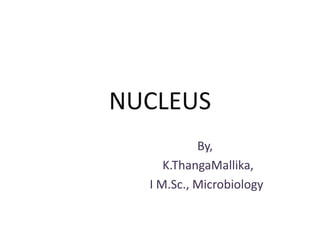
The Structure and Functions of the Cell Nucleus
- 2. INTRODUCTION • The nucleus was the first organelle to be discovered. • It was first observed by ANTON VAN LEEUWENHOEK (1632 - 1723). • In more detail in 1831 by Scottish Botanist ROBERT BROWN was observed and named it as “aerola” or “nucleus”.
- 3. OCCURENCE • OCCURRENCE - Found in all eukaryotic cells of plants and animals. • EXCEPTIONS - Mature sieve tubes and erythrocytes. • Prokaryotes (Bacteria) lack true nucleus. • POSITION - Usually at the centre but it can change its position according to the metabolic state. • NUMBER - Mononucleate , Binucleate and Polynucleate cells.
- 4. • SHAPE AND SIZE : Its shape is related with the shape of the cell. It may be spherical or ellipsoidal. • Its size is related with number of the chromosomes. Eg: small in haploid cell and large in diploid cell. • Its size also depends upon the volume of the cell, amount of DNA, proteins and metabolic phase of the cell.
- 6. ULTRA STRUCTURE • Larger organelle of the cell. • Approximately 6 micrometer in diameter. • Occupies about 10% of total volume of cell. DIFFERENT PARTS: 1. Nuclear Envelope 2. Nuclear lamina 3. Nucleoplasm 4. Chromatin fibres 5. Nucleolus
- 8. 1. NUCLEAR ENVELOPE : • Nuclear membrane, outer most covering of nucleus. • It acts as a barrier to prevent macro molecules from diffusing freely between nucleoplasm and cytoplasm. • It contains 2 cellular membranes: 1.Inner membrane 2.Outer membrane .
- 9. • They are arranged parallel to one another . • The space between 2 membranes – perinuclear space. • The outer membrane is continuous with the membrane of golgi body, mitochondria, Endoplasmic Reticulum, also studded with ribosomes. • Nuclear membrane is not continuous but broken at regular intervals, these broker areas are known as Nuclear Pores.
- 10. • Inner nuclear membrane : 5 to 10 mm thick. It contains Proteins. It acts as a main dwelling for many inner nuclear membrane pores. • Outer nuclear membrane : perinuclear space occupies 10 to 500 mm diameter. It continues with Endoplasmic reticulum, studded with ribosomes . • It also contains fibres, lipid droplets, crystalline deposits.
- 11. a. NUCLEAR PORES: • Nuclear membrane is not continuous but broke at regular intervals, these broken areas are known as Nuclear pores. • They can vary in number and it depends on species and types of the cell. Eg: Mammalian cell has 3000 to 4000 pores. • The pores are circular structure and it consists of Annuli.
- 12. 2. NUCLEAR LAMINA: • Mostly composed of lamina proteins, which synthesized in the cytoplasm and later transported into nucleus. • Lamin: Fibrous protein providing structural function and for the cell nucleus. • The lamin may be involved in the functional organization of the nucleus. • They may play a role in assembly and disassembly before and after mitosis.
- 14. 3. NUCLEOPLASM: • The space between nuclear envelope and nucleolus is filled by a transparent, semi solid granular substance is known as nucleoplasm. • It is composed of nucleo protien and contains inorganic and organic substances. • It is similar to cytosol.
- 15. 4. CHROMATIN FIBRES : • Chromatin is a mass of DNA and proteins that condense to form chromosomes during cell division. • Chromatin is an essential part of genetic makeup of eukaryotic cells, by controlling replication, cell function and storing genetic information. • The basic structure for chromatin if the NUCLEOPLASM.
- 17. 5. NUCLEOLUS: • It is composed of the main products of the rRNA genes, as well as their proteins and enzymes. • It is a large spherical and acidophilic dense granule. • Size depends on the synthetic activities of the cell. • Malfunction can leads to several human diseases.
- 18. FUNCTIONS • The nucleus contains most of the cell nucleus in the form of chromatin. The chromatin then organize into chromosomes during cell division. The chromosome contains a set number of genes and it controls every single trait. • It controls all the activities inside the cell such as cell growth, metabolism, protein synthesis. • It has instructions for making proteins and other molecules.
- 19. THANK YOU